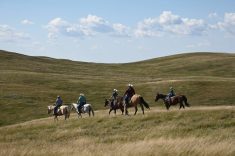The concept of feeding TMR diets formulated with ensiled forage was introduced to dairies across Canada in the early 1990s.
Until then, most dairy producers fed their cows dry hay, followed by a scoop or pull (parlour) of grain ration. I remember a visit to Eastern Canada at that time, and I saw newly made TMRs for lactating dairy cows that contained corn silage, some alfalfa or grass hay and grain ration.
A handful sample was fluffy and seemed to be dried out. As a result, the milk cows had a field day and sorted them extensively, which made cases of severe acidosis, left displaced abomasum (LDAs) and low butterfat quite common during these early TMR days.
Read Also

Harvest wraps up and fall work begins
At the Eppich famly ranch in western Saskatchewan, the fall harvest was successful with few breakdowns, cows and calves have been sorted and a new tractor has arrived
Shortly after, adding water directly to the mixer wagon became a common practice to increase the density of dry diets, which stopped most of these digestive upsets and milkfat problems. Several field trials attempted to prove the optimum moisture content for lactation dairy TMR diets.
These researchers discovered that while there were several factors to be considered, 50 per cent moisture was a good average. The actual value depended on forage types, ensiled feeds, types and the kilos of grain/concentrates fed, plus feed particle size, mixing protocol and feed bunk management.
Besides, the cows will show you whether this 50 per cent moisture rule works for them or not. By nature, the palatability of their diet tends to improve and they tend to increase their “as-fed” intake when a couple of hundred pounds of water is added to a dry diet. However, cows often frustrate the dairy producer to no end when they consume more TMR when its moisture comes from adding more wet ensiled feeds compared to adding water with a rubber hose.
Adjusting the moisture/water content to a TMR in either manner will also prevent a lot of “sorting” by lactating dairy cows at the feed bunk. On occasion, I will see milk cows at the feed bunk toss a mouthful of dry TMR up in the air toward their backs and lick up the trashed grain and concentrate particles that fall out right in front of them. So it is much harder for them to separate components of a well-mixed lactating TMR, as the research shows that is about 50 per cent moisture. To achieve this goal, dairy producers can add up to seven kilograms (15 lbs.) of water per lactating head into a TMR diet to bring its moisture content into this optimum range.
As a dairy nutritionist, I often take several steps back and I want to know the moisture of all ensiled feeds that are formulated in the final TMR in the feed bunk. That’s because even modest changes to the moisture content of ensiled forages such as corn silage can significantly change the amount of nutritious feed (contained in the dry matter part of the ration) eaten by lactating dairy cows, which ultimately is turned into milk.
Properly measured
No guesses allowed! This means that I rely upon a proper laboratory feed or home-determined (Koster) analysis. On a recent visit to a 325-cow dairy, the producer gave me a recorded seven days of ‘as-fed’ feed intake for his lactating cow herd of 229,400 lbs., or 104 lbs. per head daily. His TMR moisture (Koster tests) were consistently around 52 per cent, which means that his current dry matter intake was about 54 lbs. per cow. He gave me a new corn silage sample and a new final TMR mix to be sent to a certified feed laboratory to verify their moisture contents.
It’s a good practice implemented on his farm, because a few years ago this producer was in a hurry and added new corn silage at the rate of 40 per cent to the lactation diet without a proper moisture test. He wrongfully assumed that it had a moisture content of 65 per cent, but in reality, it contained 70 per cent. This meant that the final dairy diet was wetter by two per cent, which dropped the average DMI of his herd. Within a couple of days there was a loss of five lbs. of milk per lactating cow, before the producer realized what was happening (Research shows 1 lb. DMI = 2.5 lb. milk produced, source: University of Illinois). Luckily, he took corrective action.
This demonstrates that optimizing the moisture content in lactation dairy diets is very important in achieving optimum dry matter intakes in lactating dairy cows. It’s also true with the advent of robotic-milking barns; balancing the TMR, aside from the robot pellets, should still be moisture-balanced with the “50 per cent moisture rule”, which also holds water.
















